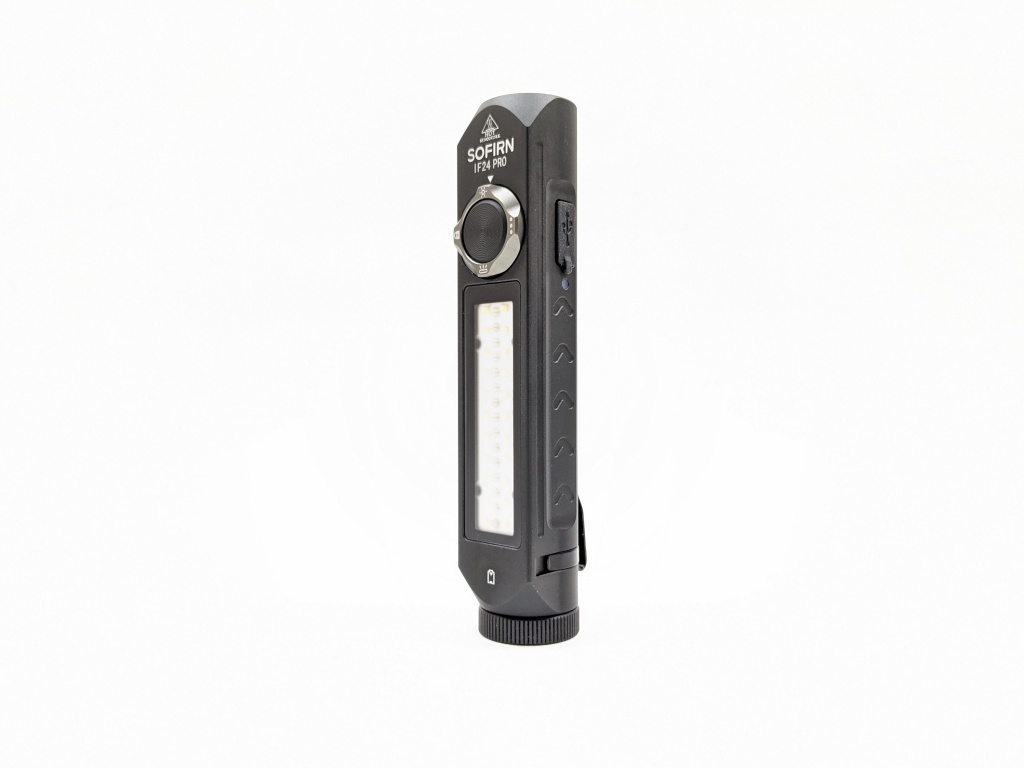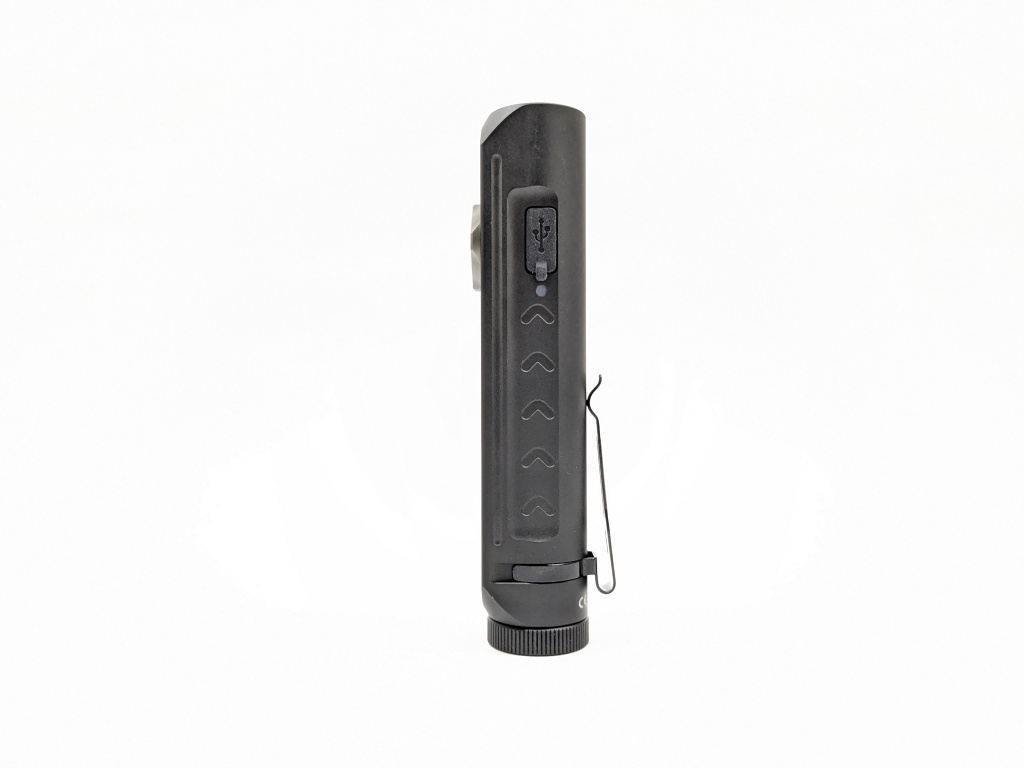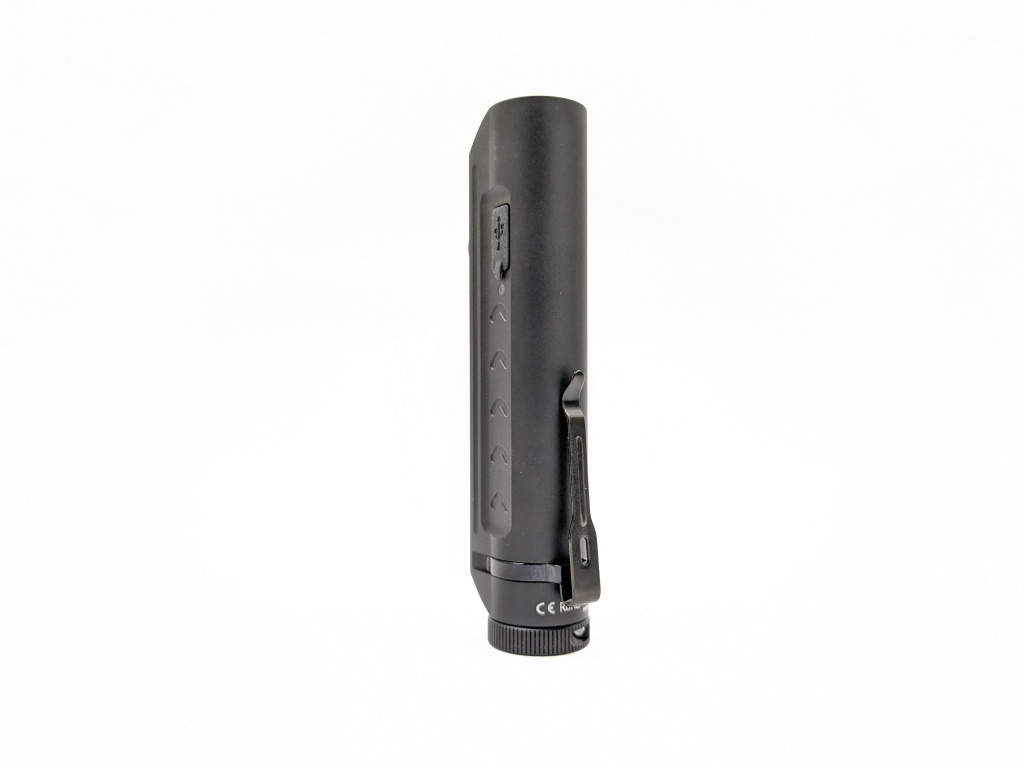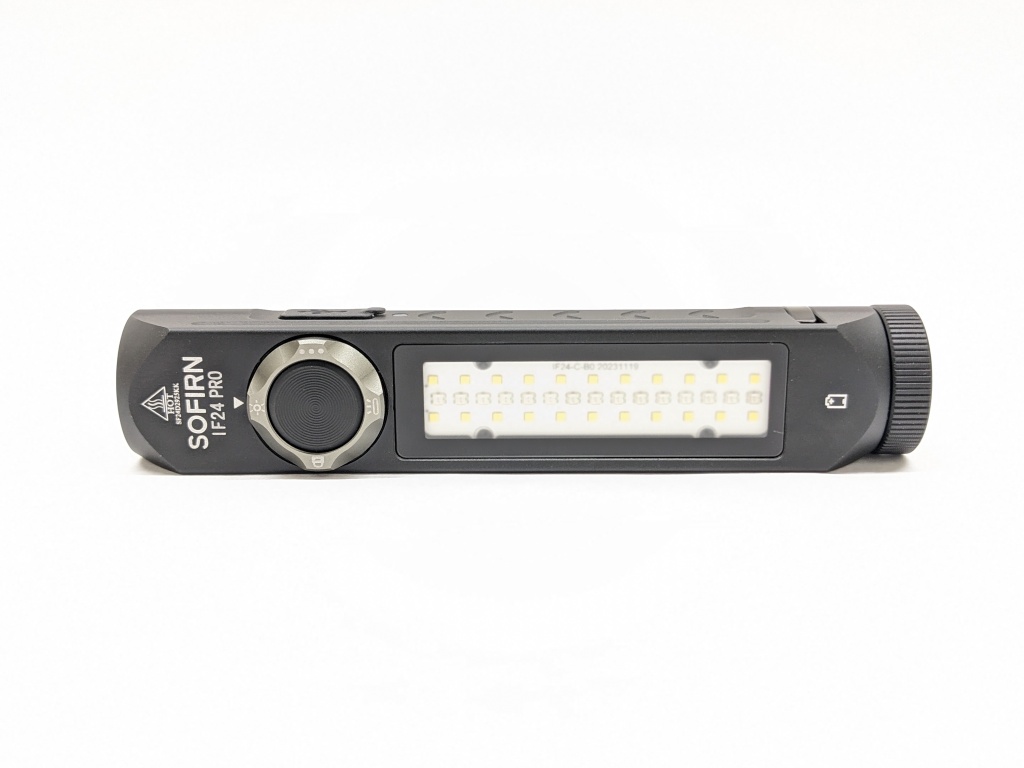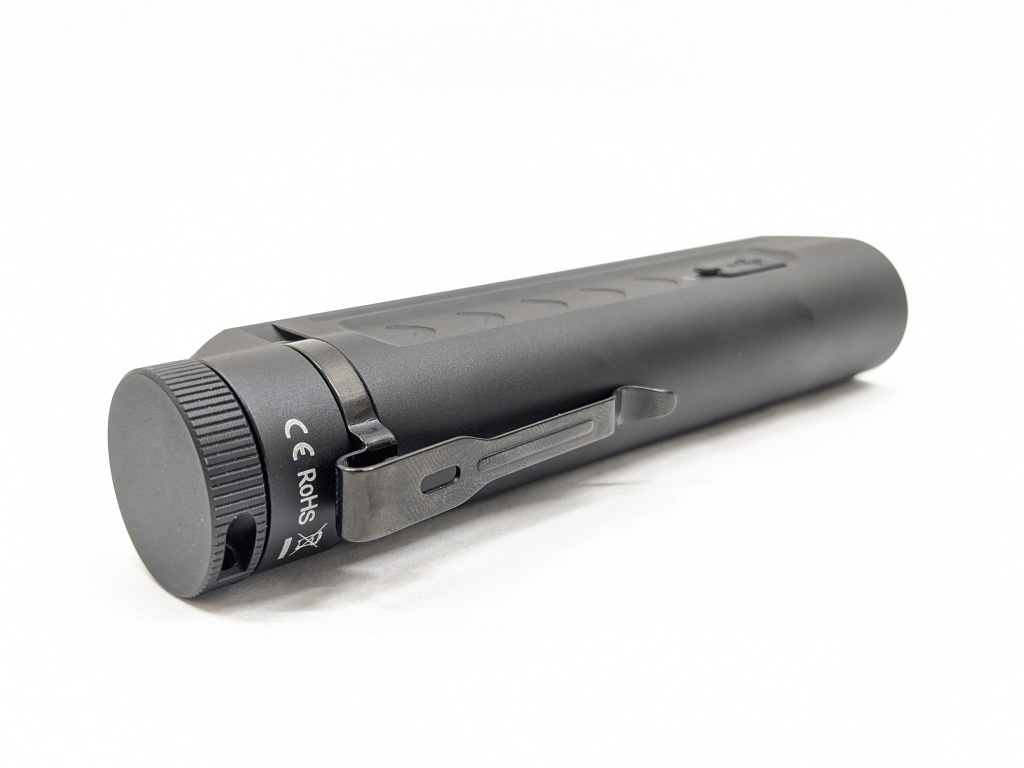Contents
- Pricing & Availability
- What comes in the box?
- Design & Construction
- Size & Measurements
- User Interface
- Emitter & Beam
- Mode Chart
- Runtime
- Driver & Regulation
- Switch
- Carry & Ergonomics
- Batteries & Charging
- Competition
- Conclusion
Pricing & Availability
Sofirn sent me this light in exchange for an honest review. Here is the official product page where you can see current pricing. They also sent me code “May10OFF” for 10% off anything on their website that isn’t on sale.
What comes in the box?
The box is one of Sofirn’s white retail boxes with a magnetic closure and a nicely printed sleeve. It’s a great “unboxing experience” but it doesn’t convey value for money like their old brown cardboard boxes did. Notably, the box says IF24, not IF24 Pro, but Sofirn says they are updating the packaging. Inside is:
- The light itself
- Battery (inside the light)
- User manual
- USB A-to-C charging cable
- Wrist lanyard
- Spare O-rings
Design & Construction
IF24 Pro’s design is excellent. It’s highly functional and Sofirn did a great job making it look good. I love the frosted (glass?) panel glued into the side and I think it looks more refined than the big aluminum plate they used on IF23.
Build quality is pretty good overall. The anodizing is on the matte/chalky side.
Size & Measurements
Sofirn IF24 Pro | Sofirn IF24

Skilhunt EC200 | Sofirn SP31 V3 | IF24 Pro | Nitecore EDC33 | Mini Maglite

| Measurement | Measured (mm) |
|---|---|
| Width | 24.1 |
| Thickness | 24.9 |
| Maximum Head Diameter | 30.2 |
| Length | 125.9 |
| Switch Diameter | 14.9 |
| Switch Proudness | 0.0 |
| Lens Thickness | U/M |
| Lens Diameter | U/M |
| Optic Diameter | U/M |
| Optic Height | U/M |
| MCPCB Size | U/M |
| LED Footprint | 5050 (3V) |
| Pocket Clip Slot Width | 4.1 |
| Pocket Clip Slot Diameter | 22.0 |
| Tailcap Diameter | 24.5 |
| Driver Diameter | U/M |
| Included Battery Length | 66.9 |
| Weight with included battery: | 147g |
User Interface
This is the best UI I’ve seen on a light with so many different LEDs and functions. It’s not perfect, but it’s dramatically more intuitive than the outgoing IF23 model and the competition.
The actions are # of presses followed by a hold (H) or a release (C) on the main switch. So, “1C” is one click and release. “2H” is two clicks but you hold down the last one. The UI is the same between both white channels.
| State | Action | Result |
|---|---|---|
| Off | 1C | On (mode memory) |
| Off | 1H | Moonlight (not memorized) |
| On | 1C | Off (usually) |
| On | 1H | Cycle mode (low-med-high) |
| Any | 2C | Turbo |
| Turbo | 2C | Strobe |
| Strobe | 2C | SOS |
| SOS | 2C | Beacon |
| State | Action | Result |
|---|---|---|
| Off | 1C | On (usually defaults to red) |
| On | 1C | Return (either off, or exit effects and go back to constant on) |
| Any | 2C | Enter or cycle color effects (shown below) |
What they got right:
- Channel switching is on a separate, dedicated switch. My biggest gripe with Sofirn IF23 was that all the functions were crammed into a single switch. That made the UI cluttered and confusing. Separating channel switching into a separate rotary switch is a fabulous solution. Adding Lockout to that separate switch is the icing on the cake!
- Clicking turns the light on/off and holding the button changes modes. That’s the way almost all e-switch flashlights should work. It’s intuitive and quick.
- Most common shortcuts work. Moonlight & Turbo have shortcuts that work like most other lights. They work very well and there’s no learning curve when switching lights. I wish I could say the same for Strobe.
- There are 5 brightness levels, which is just the right amount. Enough options without becoming cumbersome.
- Turbo, Moonlight, and Strobe are not memorized. Each has a dedicated shortcut, so you can access them quickly without overriding your memorized mode.
- 1H from Moonlight goes to Low. That means you can get to Low mode without having to go through brighter modes if you don’t have it memorized.
What they got wrong:
- 1C from Turbo, Strobe, or Color Effects returns to the previous state/mode. 1C from anywhere should turn the light off every time. 2C from Turbo is the best way to return to the previous mode. Almost every Sofirn model has this weird “return to previous state” behavior and I wish they would change it. This one is even worse because…
- 2C from Turbo activates Strobe. On many other lights, that returns to the previous mode. Most lights use 3C from anywhere to access Strobe and that works well. I wish Sofirn had stayed more in line with common UI trends here.
- Changing the channel turns it on. I found that it’s a little jarring, especially the side LEDs because they point at your face when changing channels. I found that any time I used the side LEDs I wanted to put it back on the front channel before pocketing it, so I had to rotate the switch and then turn it back off. It also means I have to loosen the tailcap if I want to fidget with the nice rotary switch.
Notes:
- There’s no way to activate both the front and side LEDs. I don’t think that’s a problem because I can’t imagine a situation where I’d want to do that.
- There is no smooth ramping option. Many other Sofirn models let the user choose stepped or smooth, but here you must use stepped modes.
Emitter & Beam


Sofirn chose Luminus SFT40 5000K for the front beam. It’s bright, intense, and efficient. Plus, it’s in a neutral white color temperature. It sits behind a plastic TIR optic and I can’t tell if there’s a glass lens over top. I didn’t try to remove the bezel because I didn’t want to scratch it. A 3D printed tool just for this bezel would work best, but you may be able to remove it with some snap ring pliers or a camera lens filter wrench.


While I like the idea of this LED, it doesn’t play well with this optic. The tighter hotspot and increased throw are nice, but the corona is lopsided and there’s a big ugly ring. The standard IF24 with an SST40 LED has a much cleaner beam. Neither has a lot of spill.

I don’t know the model of the side LEDs. They’re all domeless; the white ones are 5000K and High CRI. They all sit under the frosted cover that I think is glass. It’s glued in place and can’t be removed.
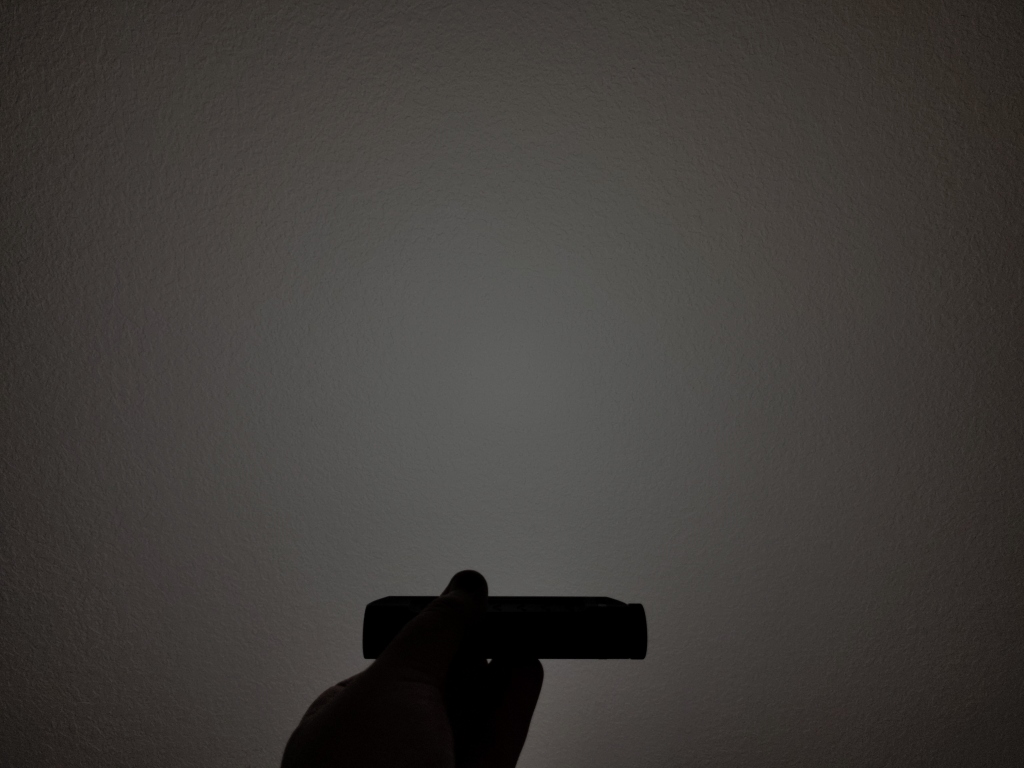
The side beam is extremely diffused and has nicer color properties.
In the beamshots below, camera settings are fixed and the wall is 2.8M away.


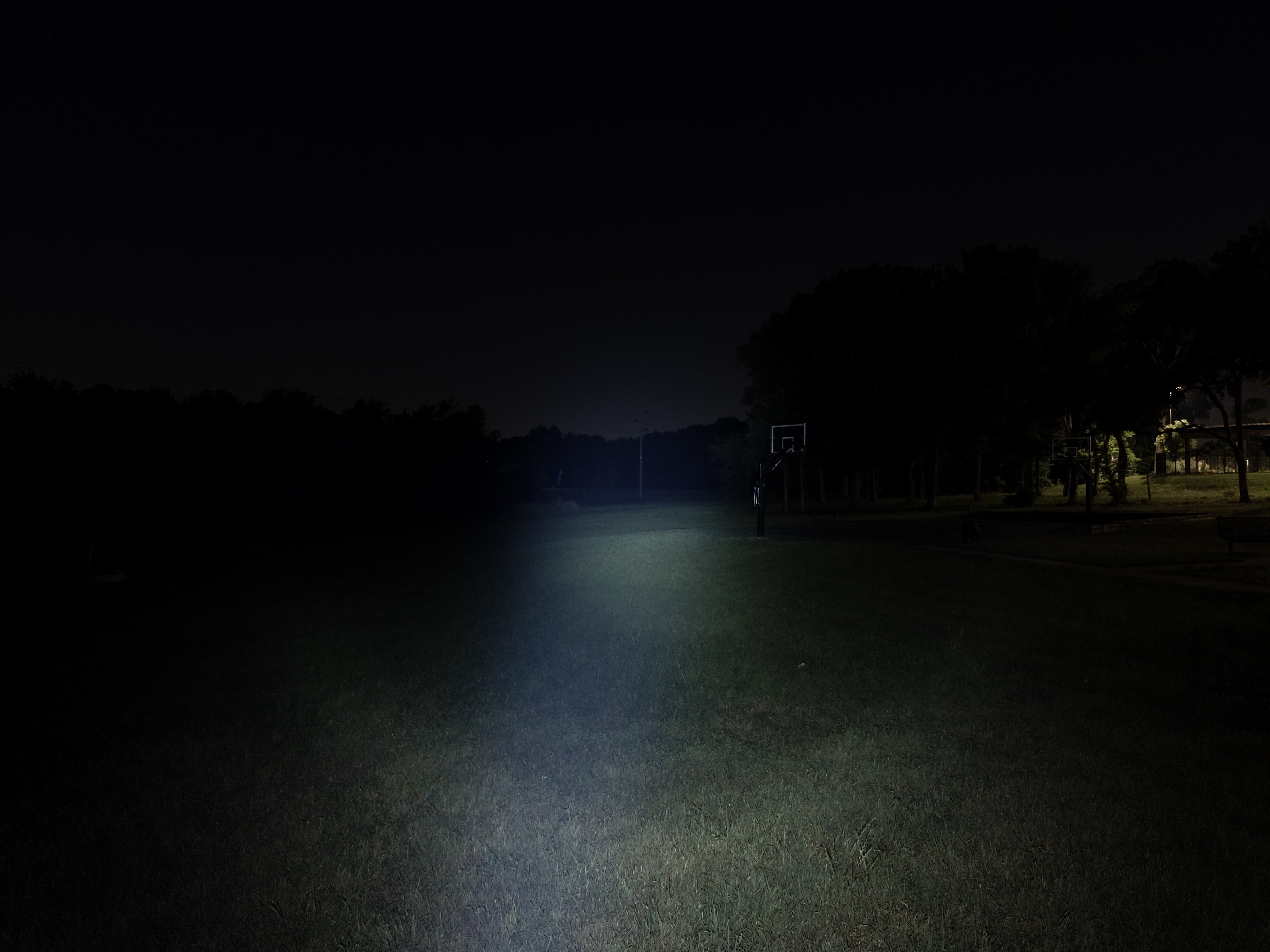


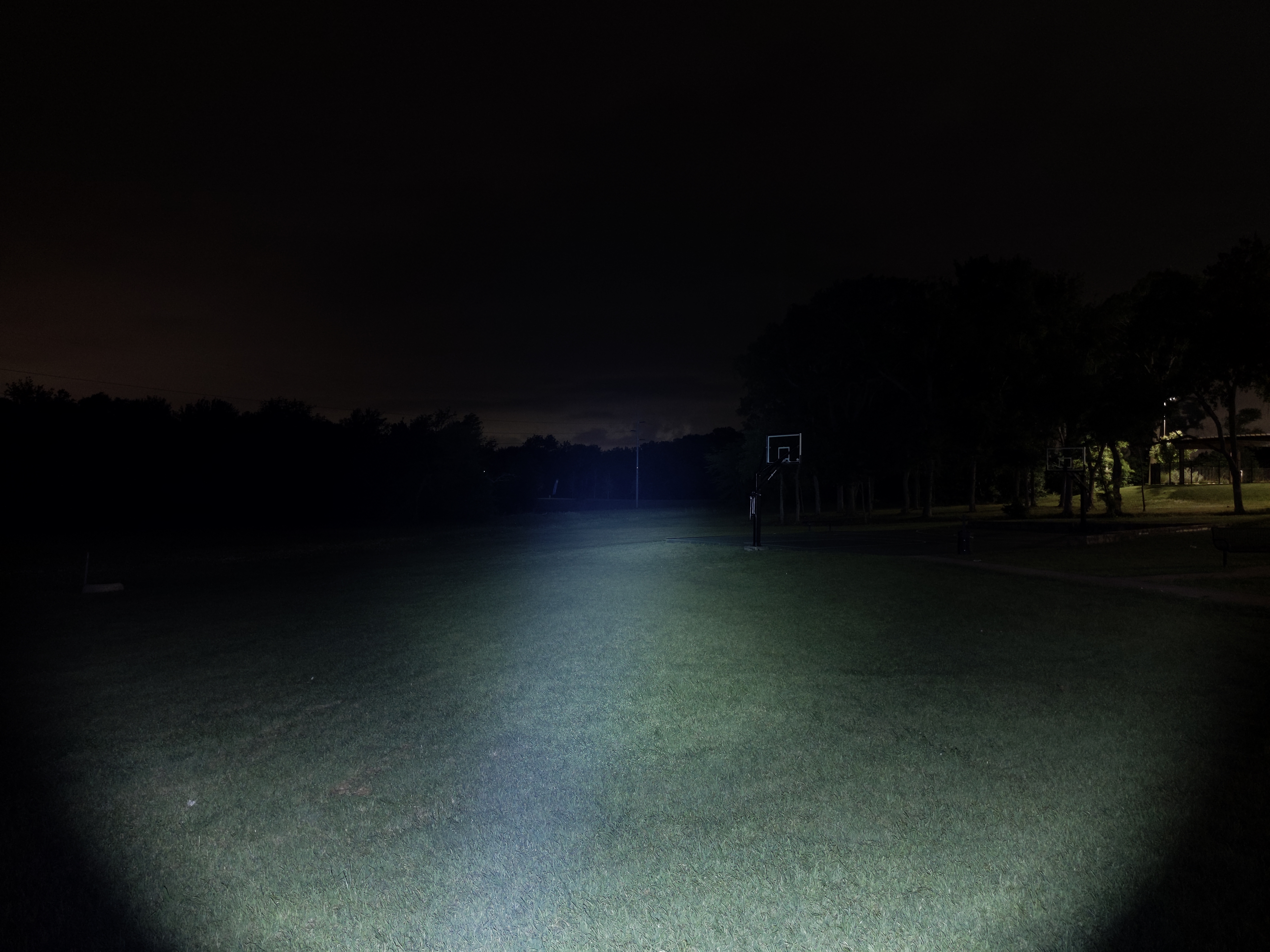

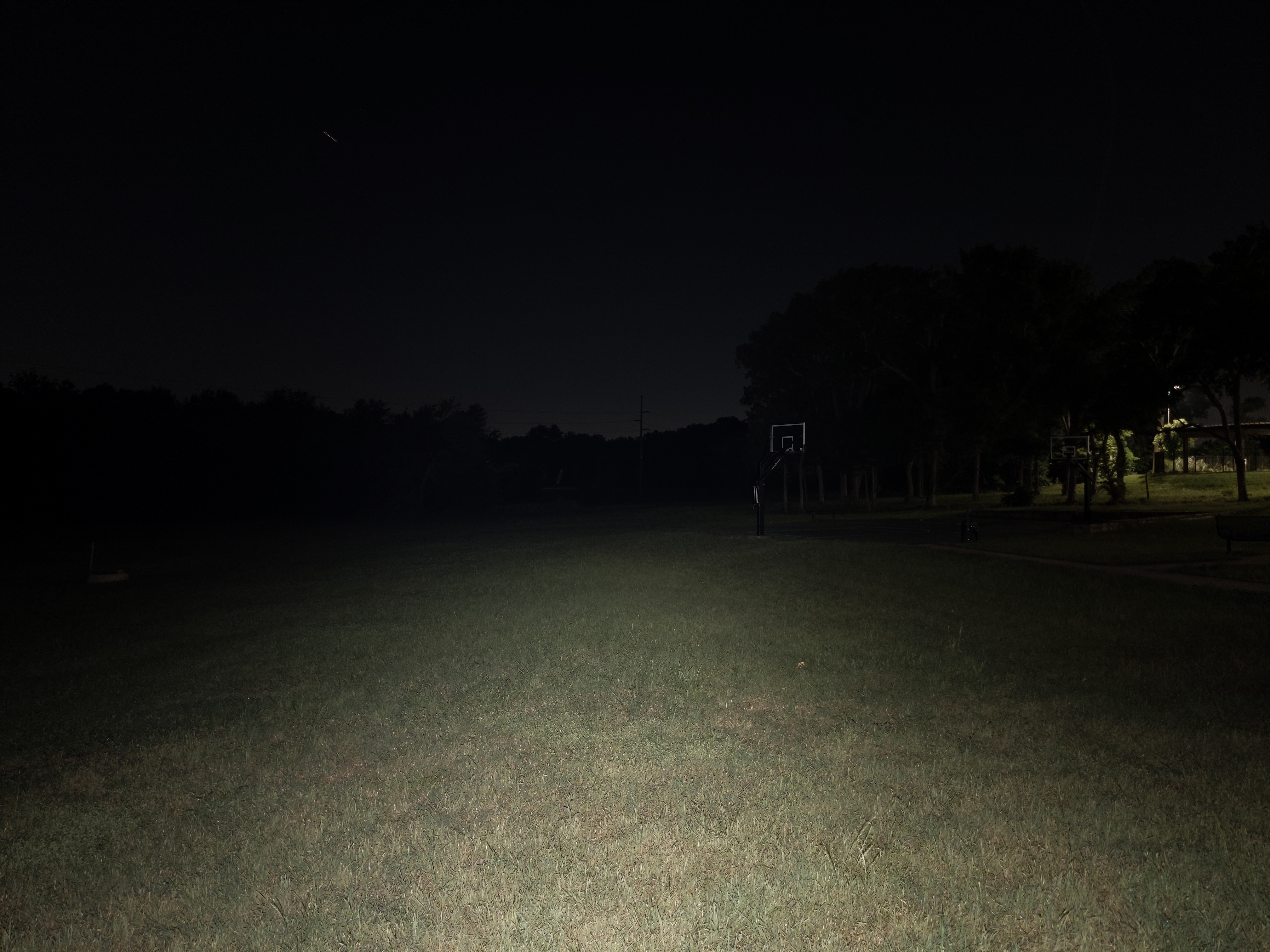
In the beamshots below, camera settings are fixed, the basketball goal to the right of the hotspot is 39M away, and the power pole in the center is 185M away.






Mode Chart
Disclaimer: All of my measurements are taken at turn-on. Lumen measurements were taken on a Texas Ace 3.5″ Lumen Tube. A candela measurement was taken at 10 meters with an Opple Light Master III on the highest brightness, and other candela figures were calculated relative to that. CRI, CCT, & DUV data were taken for each mode from a few feet away at the center of the hotspot with the Opple Light Master and Waveform DUV Calculator. Runtime tests were performed with the Ceilingbounce app on my smartphone. These tests were performed with a fully charged included battery unless otherwise specified. I cannot measure moonlight directly, so moonlight readings are calculated based on the brightness relative to the next-lowest mode. None of this is professional equipment, so take these measurements with a grain of salt.

Above are the official specs, followed by my own measurements below.
| Level | Lumens | Candela | Throw (Meters) | CRI (Ra) | Color Temp. (K) | DUV (Tint) |
| Turbo | 1300 | 33000 | 363 | 65 | 5290 | 0.0038 |
| High | 760 | 19292 | 278 | 63 | 4890 | 0.0059 |
| Medium | 210 | 5331 | 146 | 62 | 4620 | 0.0079 |
| Low | 16 | 406 | 40 | 66 | 4520 | 0.0066 |
| Moonlight | 1.8 | 46 | 14 | 64 | 4560 | 0.0082 |
| Level | Lumens | Candela | Throw (Meters) | CRI (Ra) | Color Temp. (K) | DUV (Tint) |
| Turbo | 490 | 260 | 32 | 98 | 5090 | 0.0046 |
| High | 190 | 101 | 20 | 98 | 5090 | 0.0061 |
| Medium | 74 | 39 | 13 | 98 | 5070 | 0.0063 |
| Low | 9 | 5 | 4 | 99 | 4980 | 0.0054 |
| Moonlight | 0.5 | N/M | N/M | 100 | 5060 | 0.0042 |
Runtime


Front LED performance is good. It’s all in line with other buck-driven 18650 lights I’ve tested. Turbo time and peak output are a bit lower than IF24, but sustained output and regulation are much better.


Side LED performance is virtually identical to IF24. The regulation is pretty poor so the brightness continually drops with battery voltage. Total runtime is respectable.
Thermal regulation is not present as far as I can tell. My Turbo and Turbo Cooled (desk fan blowing on the light) tests were nearly identical.
LVP (Low Voltage Protection) is present. The light will shut itself off when the battery is effectively empty. It can be temporarily reactivated in an emergency.
Driver & Regulation
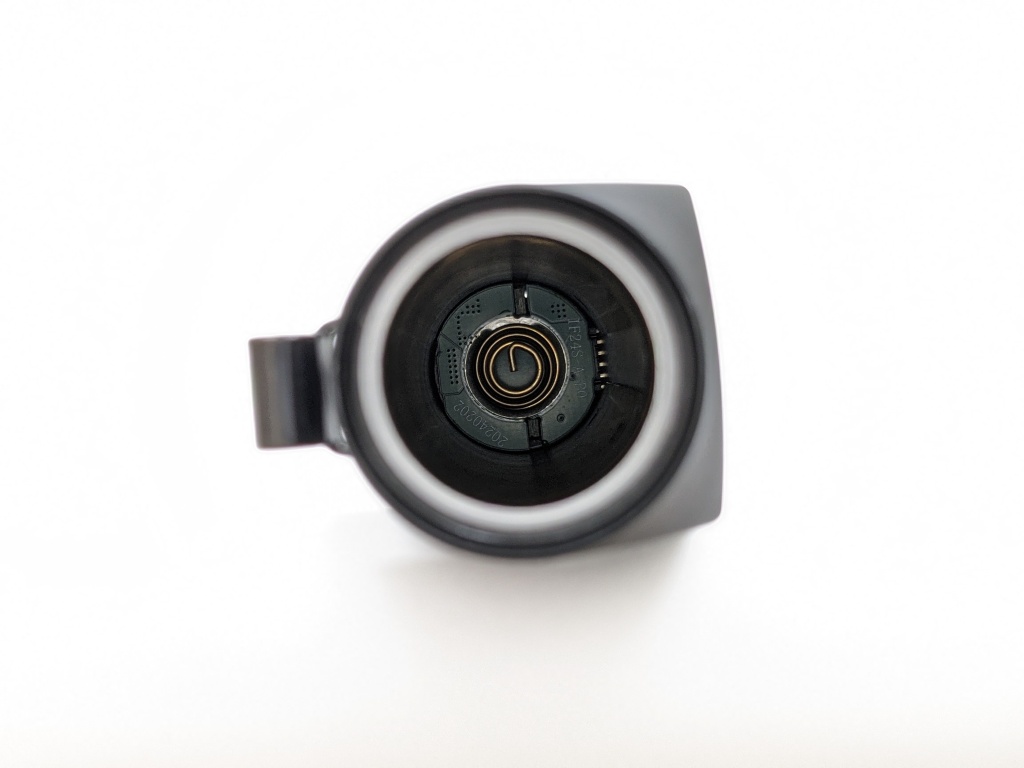
One of the key features of the IF24 Pro is the buck driver. That should make it more efficient and better regulated than IF24.


Front LED regulation is good. It’s only noticeably affected by battery voltage when the battery is virtually empty. Well done, Sofirn. This is dramatically better than IF24.
Side LED regulation is poor because it’s FET driven instead of Buck driven like the front LED. It’s identical to IF24’s side LED performance so I didn’t do dedicated regulation testing on it.
Note: All regulation measurements are taken at turn-on so they do not reflect any thermal or low voltage stepdowns that may occur. A value of 0 indicates low voltage shutoff immediately upon activation.
PWM: My Opple detected some flickering (not PWM) on the front Moonlight, Low, and Medium modes. I can’t see or hear any flickering though, and my phone camera doesn’t detect it. My Opple also detected some definitely PWM on all white side LED modes except Moonlight. Once again, I cannot see or hear it, but my phone camera can pick it up from the side LEDs.
Parasitic Drain: 23 microamps. That will take 15 years to drain the included battery.
Switch

IF24 (Pro)’s switch is the biggest improvement over IF23. Not only does it have a main e-switch for on/off and brightness changes, but there’s now a 4-position rotary switch to switch among the 3 different channels and lockout. That makes it dramatically more intuitive to use.
That rotary switch has raised points for grip and detents so it snaps into place. The e-switch is clicky and has a nice action. Both switches are placed so they’re easily accessible when holding the light. This is an excellent switch setup.
Carry & Ergonomics
Ergonomics are good. The light fits well in the hand and my thumb rests nicely on the button. Turning the rotary selector is pretty easy but I don’t think it will get rotated by accident. A forward grip is the only grip that works on this light.

The clip seems a little small to me, but it works. I’m glad it only goes in one direction. The bidirectional clips that let you clip a light to your hat can be handy, but they snag on things more easily. This light is too big and heavy to clip to a hat anyway. The clip sometimes gets hung up early on that sharp corner where it attaches to the light. I would have liked to see that rounded off.
A magnet inside the tailcap is strong enough to hold the light securely on a vertical surface. Handy!
Batteries & Charging

Battery: IF24 Pro uses a single 18650 battery. Sofirn optionally includes their standard 3000mah, unprotected, button-top cell, which works fine. Unprotected flat tops work great too. I fit a protected button top from Skilhunt (69.2mm), but just barely. I don’t think a battery with a USB port on it would fit. IF23 used a larger 21700 battery, so going down to an 18650 is a notable change. It does make the light a little thinner.
Charging is facilitated by a USB-C port with a rubber cover. Both A-to-C and C-to-C cables work fine. There is no powerbank function here like there was on IF23. The light is fully functional while charging with the battery connected. If you remove the battery (or just unscrew the tailcap) while it’s plugged in, you lose Turbo mode, the mode rotation reverses (High-Med-Low), and there’s an audible whine on High and Low modes. The RGB UI is unaffected.
There’s a charging indicator next to the charging port. When plugged in, red means charging, and green means fully charged. When unplugged, the indicator will activate for a few seconds after you turn on the light. In that case, green means 50-100% charge, red means 10-50% charge, and blinking red means <10% charge.
Competition
Here are some lights in the same class and how they compare.
- marginally lower price
- marginally shorter and wider
- single switch only (no rotary knob)
- higher brightness
- larger battery
- worse quality driver
- dramatically worse user interface
- powerbank function
- fewer RGB functions
- XHP50.2 LED & reflector
- large bidirectional clip (might get snagged on stuff, too heavy to clip to a hat)
- identical to IF24 Pro EXCEPT:
- SST40 CW LED (less throw, cooler temp, cleaner beam)
- FET driver (less efficient, poor regulation)
- marginally less expensive
- marginally higher price
- worse quality driver
- flat shape
- built-in battery
- green laser
- dual buttons instead of one button and a rotary switch
This section is not comprehensive. If I didn’t include a particular light here, it doesn’t mean it’s bad or doesn’t deserve to be here. I simply cannot list every possible competitor.
Conclusion
When I reviewed Sofirn IF23, I concluded that buyers would be better off with a regular flashlight and one of those RGBW photo light panels. That’s not so with IF24 (Pro). Sofirn has done a fabulous job combining a traditional flashlight, a side floodlight, and addressable RGB LEDs into an EDC-size package. This updated “Pro” version includes a better driver and a (mostly) better beam. Both are great choices!
Thanks to Sofirn for sending me this light for review!





